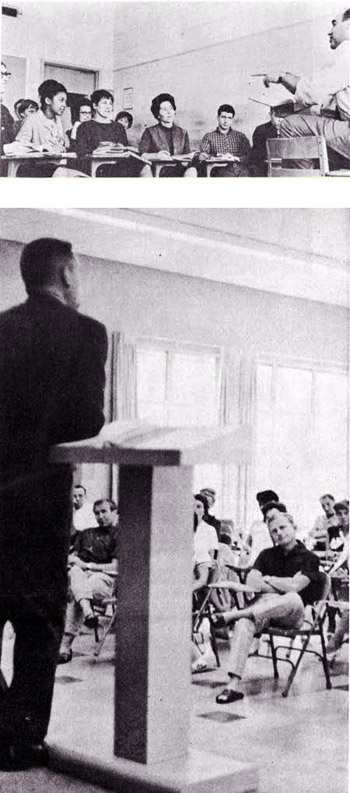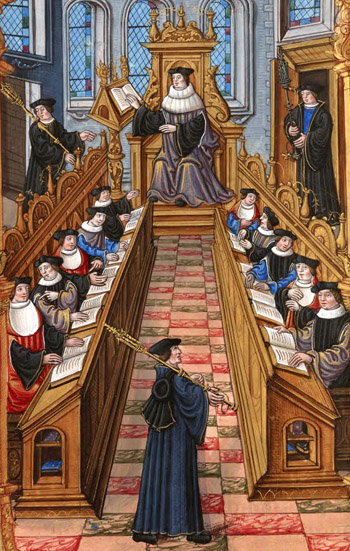Organic Society
 |
 |
 |
 |
 |
 |
 |
Hierarchy, a Principle the Revolution Is
Increasingly Rejecting
A common room with bare walls that could serve equally for a clinic, a cooperative administration office or a classroom. The presence of chairs adapted to take notes, the arrangement of the furniture and the fact that some persons in the front row have books and binders allows one to realize that the picture shows us a classroom.
 But one can ask whether, at the time the photo was taken, a lesson was being given or the jovial fellow in his shirt sleeves and his foot on a chair is just a student who took advantage of a break to tell some jokes.
But one can ask whether, at the time the photo was taken, a lesson was being given or the jovial fellow in his shirt sleeves and his foot on a chair is just a student who took advantage of a break to tell some jokes.
The second hypothesis seems more likely. The comic attitude of the person, the laughter of some of those listening, invites us to this conclusion. Let us say, nonetheless, that it is a class. What kind of class would it be? A high school for adults? A driving school? A university course where the professor guides students through the higher horizons of thinking?
It is difficult to answer based on the photo. It can be any one of the above, or something completely different. An analysis reveals that the ambiance of that classroom, inexpressive and insignificant, does nothing to assist the mentality of those present to realize with all the richness of soul the specific work to which they are called. Rather, the ambiance is opposed to the natural demands of the human spirit and, therefore, it is inhuman.
Much the same observations could be made with respect to the second photo. The listeners are older. No one is laughing. There is nothing comical in the attitude of the person who is speaking. The room and the furnishings suggest a somewhat more elevated standing.
But a similar undefined note hovers in the ambiance. Is this a vacation course at a beach hotel or treatment resort? Or a sermon in some ultra-modernized Protestant sect? The lectern that the speaker stands behind has something of a pulpit about it... Nothing opposes, however, the supposition that some theoretical explanation in a short course of chess or bridge is being given in this room.
In other words, one notes the same error in the ambience pointed out in the previous picture: the complete lack of a specific and defined relationship between the nature of the activity taking place in the room and the thinking of those present in it. Likewise, the room, the furniture, and the clothing of the personages tell us nothing about what is taking place there.
*
In fact, the two pictures show classrooms - with professors and students – respectively, at Wayne State University in Detroit and Springfield College in Massachusetts in the '60s.
The principle underlying the serious psychological error that makes these rooms inhuman – in a certain sense – is egalitarianism.
We say "inhuman" not because these rooms lack anything necessary for the body's convenience, but because, destined for superior activities of the mind, they refuse to give any support, any encouragement or any inspiration to the work of the intellect and sensibility, so filled with subtleties and imponderables.
Instead, it is fully pleasing to egalitarianism, the irreducible adversary of the differentiation and hierarchy between spirit and matter, intellectual activity and manual labor; an egalitarianism that hates such just and harmonic inequalities and opposes everything that is distinctive, characteristic and organic. An egalitarianism that longs for a trivial world, with nothing typical or expressive, where all the differentiations of class, function, place and age were destroyed and have disappeared.
*
The wisdom of all the generations that preceded the rise of this appalling error advocated the opposite.
 Here, for example, you see a study hall at the University of Paris in the Middle Ages. The students engage in a scholastic discussion under the direction of the Master. All the seriousness and nobility of intellectual activity are affirmed here with an admirable richness of expression. Everything exists to assist the Master and students to focus on and delve deeply into their high mission, to raise the mind to the noblest regions of thought.
Here, for example, you see a study hall at the University of Paris in the Middle Ages. The students engage in a scholastic discussion under the direction of the Master. All the seriousness and nobility of intellectual activity are affirmed here with an admirable richness of expression. Everything exists to assist the Master and students to focus on and delve deeply into their high mission, to raise the mind to the noblest regions of thought.
Light enters abundantly, but the colored glass windows isolating the ambience from the distractions of the outside world. The students face one another, providing ease for discussion and sight. The benches upon which they sit have the dignity and solemnity of Cathedral choir stalls. The characteristic university dress makes it easy for the students to assume a dignified interior attitude and high-minded spirit.
The nobility of the teaching function is splendidly expressed by the Master's chair, which is a veritable throne. The university beadles are at the service of the Master and students and help to maintain discipline. Their attire and attitude make them, not simple guards, but functionaries almost as solemn as magistrates.
Religious elements are strongly present: the book stand that holds the text consulted by the Master has a group carved in wood representing the Annunciation. The staffs carried by the beadles frequently held relics. Teaching and discipline were turned to the most stimulating topic in the intellectual sphere, that is, the faith. In this regard, the room contrasts with the glacially-cold secular environment of the previous two pictures.
The medieval hall of the University of Paris contrasts sharply with its modern counterparts because it is completely based on the principle that the ambiance of a place must be consistent with its purpose, thus attending naturally to the demands of the human spirit. It is this noble principle of organic societies, harmoniously hierarchical and sacral, that the Revolution is increasingly rejecting.


The second hypothesis seems more likely. The comic attitude of the person, the laughter of some of those listening, invites us to this conclusion. Let us say, nonetheless, that it is a class. What kind of class would it be? A high school for adults? A driving school? A university course where the professor guides students through the higher horizons of thinking?
It is difficult to answer based on the photo. It can be any one of the above, or something completely different. An analysis reveals that the ambiance of that classroom, inexpressive and insignificant, does nothing to assist the mentality of those present to realize with all the richness of soul the specific work to which they are called. Rather, the ambiance is opposed to the natural demands of the human spirit and, therefore, it is inhuman.
Much the same observations could be made with respect to the second photo. The listeners are older. No one is laughing. There is nothing comical in the attitude of the person who is speaking. The room and the furnishings suggest a somewhat more elevated standing.
But a similar undefined note hovers in the ambiance. Is this a vacation course at a beach hotel or treatment resort? Or a sermon in some ultra-modernized Protestant sect? The lectern that the speaker stands behind has something of a pulpit about it... Nothing opposes, however, the supposition that some theoretical explanation in a short course of chess or bridge is being given in this room.
In other words, one notes the same error in the ambience pointed out in the previous picture: the complete lack of a specific and defined relationship between the nature of the activity taking place in the room and the thinking of those present in it. Likewise, the room, the furniture, and the clothing of the personages tell us nothing about what is taking place there.
In fact, the two pictures show classrooms - with professors and students – respectively, at Wayne State University in Detroit and Springfield College in Massachusetts in the '60s.
The principle underlying the serious psychological error that makes these rooms inhuman – in a certain sense – is egalitarianism.
We say "inhuman" not because these rooms lack anything necessary for the body's convenience, but because, destined for superior activities of the mind, they refuse to give any support, any encouragement or any inspiration to the work of the intellect and sensibility, so filled with subtleties and imponderables.
Instead, it is fully pleasing to egalitarianism, the irreducible adversary of the differentiation and hierarchy between spirit and matter, intellectual activity and manual labor; an egalitarianism that hates such just and harmonic inequalities and opposes everything that is distinctive, characteristic and organic. An egalitarianism that longs for a trivial world, with nothing typical or expressive, where all the differentiations of class, function, place and age were destroyed and have disappeared.
The wisdom of all the generations that preceded the rise of this appalling error advocated the opposite.

Light enters abundantly, but the colored glass windows isolating the ambience from the distractions of the outside world. The students face one another, providing ease for discussion and sight. The benches upon which they sit have the dignity and solemnity of Cathedral choir stalls. The characteristic university dress makes it easy for the students to assume a dignified interior attitude and high-minded spirit.
The nobility of the teaching function is splendidly expressed by the Master's chair, which is a veritable throne. The university beadles are at the service of the Master and students and help to maintain discipline. Their attire and attitude make them, not simple guards, but functionaries almost as solemn as magistrates.
Religious elements are strongly present: the book stand that holds the text consulted by the Master has a group carved in wood representing the Annunciation. The staffs carried by the beadles frequently held relics. Teaching and discipline were turned to the most stimulating topic in the intellectual sphere, that is, the faith. In this regard, the room contrasts with the glacially-cold secular environment of the previous two pictures.
The medieval hall of the University of Paris contrasts sharply with its modern counterparts because it is completely based on the principle that the ambiance of a place must be consistent with its purpose, thus attending naturally to the demands of the human spirit. It is this noble principle of organic societies, harmoniously hierarchical and sacral, that the Revolution is increasingly rejecting.

Catolicismo, n 198/199 – June/July of 1967
Posted January 28, 2015
Posted January 28, 2015
Organic Society was a theme dear to the late Prof. Plinio Corrêa de Oliveira. He addressed this topic on countless occasions during his life - at times in lectures for the formation of his disciples, at times in meetings with friends who gathered to study the social aspects and history of Christendom, at times just in passing.
Prof. Plinio
Atila S. Guimarães selected excerpts of these lectures and conversations from the transcripts of tapes and his own personal notes. He translated and adapted them into articles for the TIA website. In these texts fidelity to the original ideas and words is kept as much as possible.
______________________
______________________












